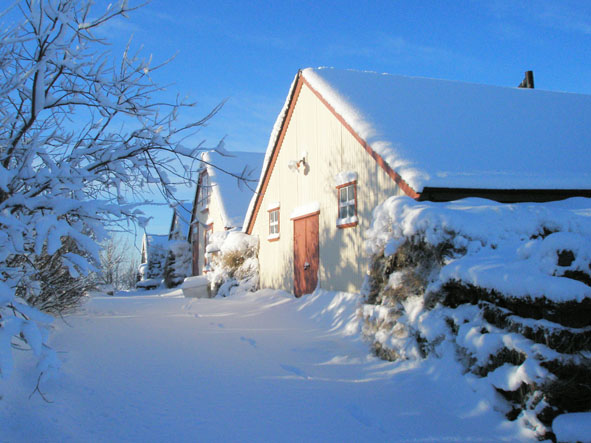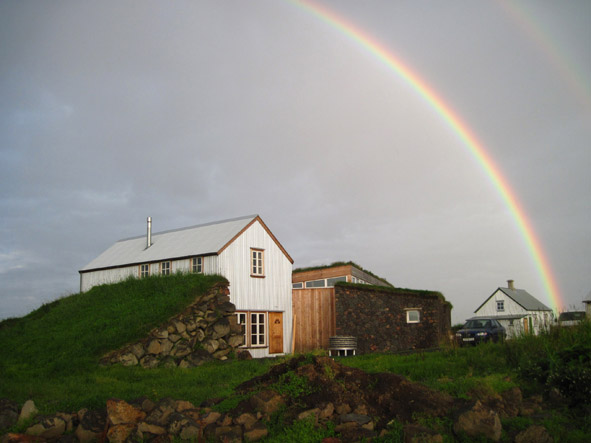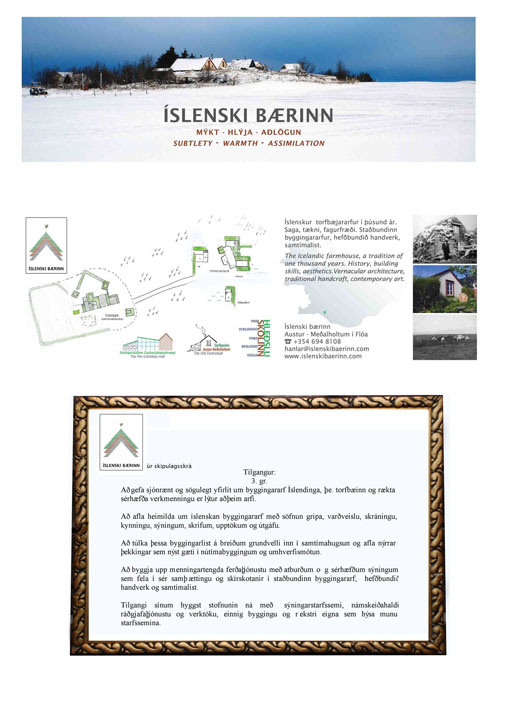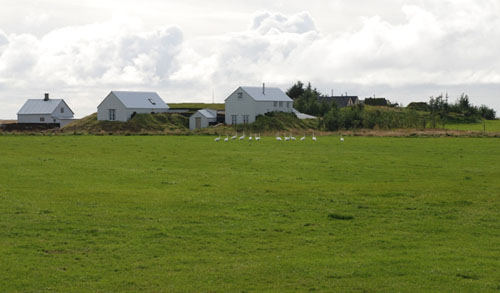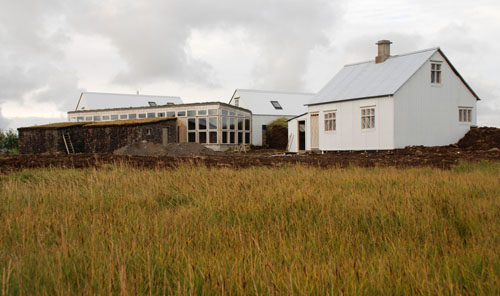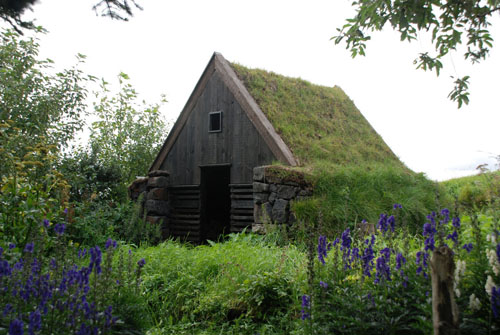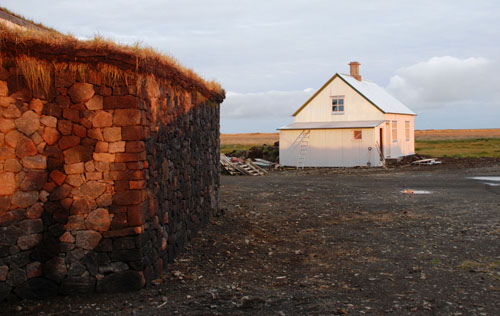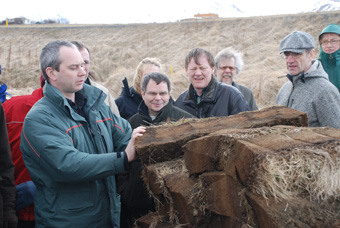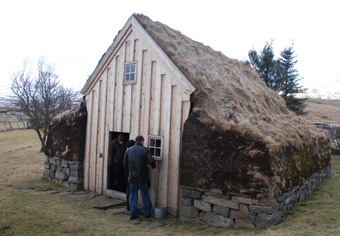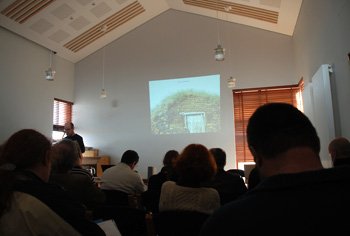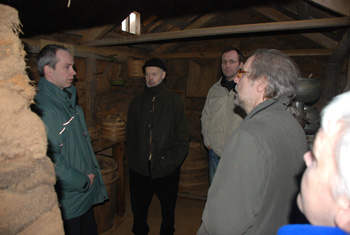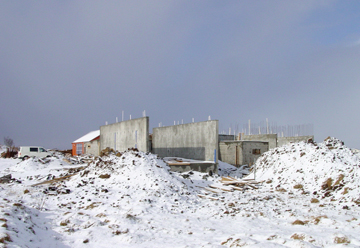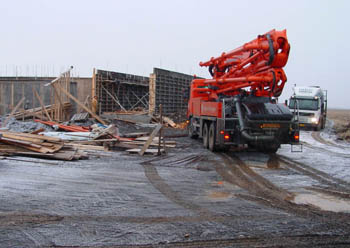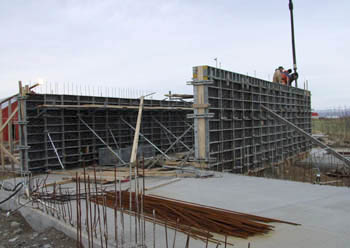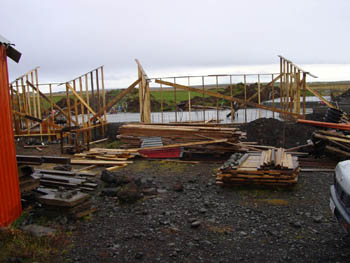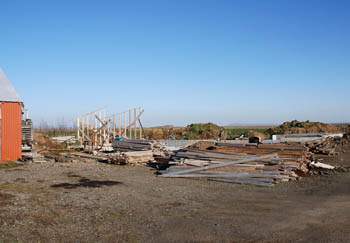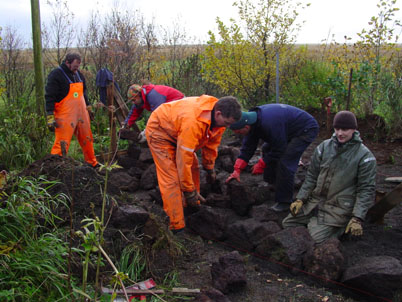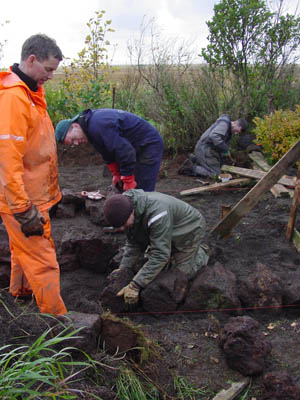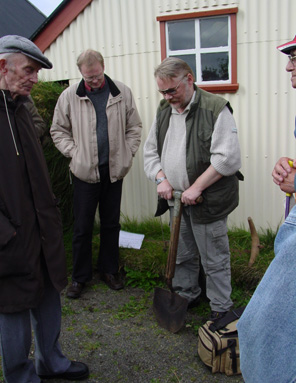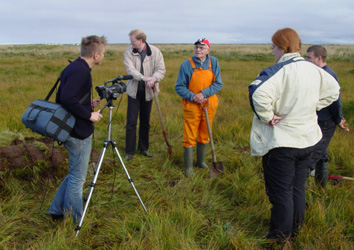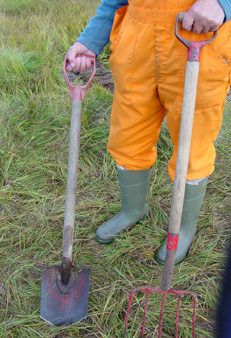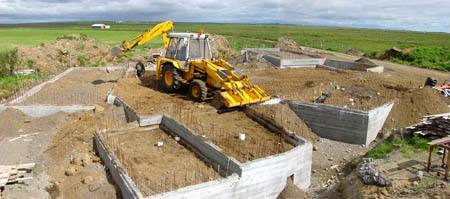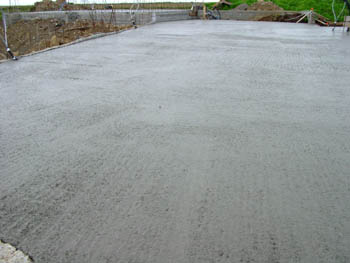Íslenski bærinn mjakast fram á við
Íslenski bærinn rís – 2008
Gleðilega jólahátíð!
Reisugildi
Framkvæmdir ganga vel og nýbyggingin tekur á sig fyllri og fyllri mynd.
Reisugilli var haldið 2. nóvember 2007 og fáni dregin að húni.
Torf í arf í góðum gír
Sýningarsalir/Exhibition Space
Húsið risið úr jörðu: 15. mars 2007
Steypa 18. desember 2006
Steypa 30. nóvember 2006
Steypa 20. nóvember 2006
Uppsláttur heldur áfram
Uppsláttur hafinn
Instructive harmony
by Hannes Lárusson
Steward of the turf-built farmhouses at Austur-Meðalholt
A short article by Thórólfur Sveinsson was published in vol. 19 of the Farmer’s Journal on November 8 [2005] under the headline “Feeling good in turf-built farms?” Thórólfur Sveinsson wishes the writer of this piece all the best in his efforts of contributing to a reappraisal of the true worth of the traditional Icelandic farmhouse, and I thank him for his good wishes. In his article, however, Thórólfur Sveinsson makes the bizarre claim that people who praise traditional farmhouses must be making fun of our forebears. My experience of these farms, which is shared by many other people, is that we by no means need to play down this heritage; on the contrary, these are admirable buildings and a credit to our forebears.
Softness and warmth
The Icelandic farmhouse has evolved over a thousand years of cohabitation between the resources of the land and available materials. It is the product of a practicality which appeared century upon century in countless variations within the same architectural form. These buildings have such a distinctive and identifiable air about them that they would stand out anywhere. However, it is always the case with local culture, and especially architecture, that it cannot easily be relocated. The Icelandic farmhouse is a deep-rooted object that sheds unique light on the living conditions and history of the northernmost part of Europe. Its primary characteristics are its organic cluster of buildings, its organic materials and above all its warmness, softness and unassuming beauty. The old farmhouses are integrated into the landscape, the seasons and the light, and are one of the best examples to be found of harmony between the natural environment and manmade structures. It is not least thanks to the ingenious use of natural building materials, taking into account their isolating properties and the strain imposed by the weather, that the Icelanders survived as a nation for centuries in spite of their geographical isolation and hardship. The old Icelandic farmhouse is never more in its element than in winter, in snow and frost, when the main sitting room embraces its inhabitants better than most other houses. Unless they are familiar with the living main room of a traditional farmhouse, no one can understand completely the concept of warmth.
Eco-friendly model
Traditional turf-built houses are constructed partly from natural materials with limited durability. The natural decay of the materials makes regular rebuilding unavoidable. If nothing is done, the reversion to nature and the land is almost absolute. The cycle of organic buildings should be seen as a natural process and an advantage rather than a flaw, from the viewpoint, for example, of environment-friendly ideologies. In the process of producing a turf-built house, man and nature make a new covenant. The regular renewal of the turf-built farm is part of its character, experience and intellectual depth. Wherever a traditional Icelandic farmhouse is on exhibit, at least one building or wall should preferably be under reconstruction.
Hyperspeed
The traditional Icelandic farmhouse is without a doubt one of the most remarkable manifestations of Icelandic farmers’ culture. The buildings provided a setting for advanced handicrafts and storytelling, thereby clearing the way for Icelanders to adopt modern technology at hyperspeed. Modernisation took place rapidly and important values tended to be forgotten in the heat of the race. In retrospect, it is incomprehensible why the farmers who could afford it were not ambitious enough to preserve part of the old farmhouse, even though it might no longer have been suitable as the main living quarters for humans or livestock. It would have been easy to find a new role for the old main rooms and adapt them to new ways of thinking, rather than literally wiping them off the face of the earth.
Exactly how people in Iceland could suddenly feel ashamed of these farmhouses rather than proud of them deserves closer scrutiny. Nowadays, there are fewer and fewer people left who experienced living in turf-built farmhouses when these were still around. So there is not much time left to examine this heritage without prejudice and make a calm and collected appraisal of its advantages and disadvantages, and draw the appropriate conclusions from that lesson.
National treasure
I disagree with the view of the old Icelandic farm as a “mouldy mud hut.” I was partly brought up in a turf-built farmhouse myself and my experience is completely different. A newly built turf farmhouse with the main room as its centre of gravity is a highly advanced structure in many ways, in terms of both utility and beauty. And few buildings are friendlier while they are new. Icelandic turf-built farmhouses with their thousand-year history and countless variations are a national treasure which must be nurtured, made visible and interpreted into the modern age with humility and dignity.
* Icelandic version see:
islenskibaerinn.com / Greinar og viðtöl / Bændablaðið, 1. tbl. 2006
Hleðslunámskeið í rammíslensku veðri.
Veður með versta móti. Fyrri daginn hífandi rok með skúraleiðingum, seinni daginn hægur vindur en þeim mun meiri rigning. Bót í máli að báða dagana var hlýtt. Þátttakendur, sem betur fer reyndust allir þaulvanir útvistarmenn, lét veður lítt á sig fá og handléku snidduna jafnt sem hraungrýtið því léttar eftir því sem á leið undir vakandi auga og jákvæðri hvatningu Björns Hrannar og Víglundar fornhleðslumeistara.
Hér hefur verið lagður hornsteinn að frekara námskeiðahaldi í verklagi sem tengist íslenska bænum.
Eins og haustdagar gerast bestir
Sniddan stungin sunnudaginn 1. október. Góður hópur saman komin sem hafði margt til nýtt til málanna að leggja. Verkfæri skoðuð og verklag rætt og skráð. Næstu daga verður hafist handa við úrvinnslu á miklu magni af efni og lagt á ráðin um framhaldið.
Sumarið 2006
Grunnur var tekinn að nýbyggingu Íslenska bæjarins síðustu dagana í apríl, síðan leiddi eitt af öðru: Slegið upp fyrir sökklum, fyllt í með möl og þjappað, einangrað og lagðar lagnir og þann 25. ágúst var platan steypt. Fram að þessu hafa framkvæmdir gengið samkvæmt áætlun og góðir menn komið að öllum verkþáttum. Nú er verið að ganga frá viðbyggingu við gömlu hlöðuna m. a. annars sem kaffi- og vinnuaðstöðu. Áætlað er að hefjast handa við næsta áfanga framkvæmdarinnar í byrjun október.




